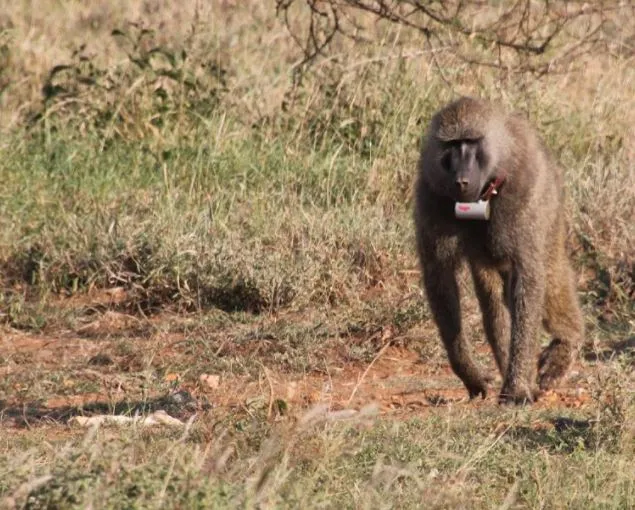Scientists have used fitness tracker technology on a troop of wild olive baboons to uncover how they stick together as a group.
The results of the research showed that travelling with a mix of ages and abilities requires compromise on the part of the long- and the short-legged – but it's the littlest baboons that draw the shortest straw.
"Anybody who has tried to walk with a toddler knows the challenges of moving with someone who has a different physical ability," said first author Dr Roi Harel, an ecologist at the Max Planck Institute of Animal Behavior.
"Small individuals pay disproportionate costs associated with maintaining group cohesion, and this might be because they have the most to gain from group membership."

The team worked with a troop of wild baboons at the Mpala Research Centre in Kenya. Prof Meg Crofoot, a senior author of the study, has worked with the animals at the centre for nearly a decade. She was the first to ever use GPS tracking on a large group of primates.
To record their data, the researchers attached GPS trackers and accelerometers to the baboons. The readings from these trackers provided information on movement behaviours for individual baboons, including their location, number of steps and locomotion speed.
While larger animals naturally took longer strides – and required fewer steps than the small, younger baboons – the researchers found that all members of the troop made compromises so that they could match the pace of their nearest walking companion – increasing their stride when travelling next to larger individuals, decreasing their stride when with smaller individuals.
"However, the size of these behavioural adjustments was not equal; smaller individuals increased their stride frequency more than their larger neighbours decreased their stride frequency," write the researchers in their paper, which was published inProceedings of The Royal Society B.
Read more about animal behaviour:
- Tamarin monkeys copy other species' accents to avoid conflict
- Female orangutans are mummy’s girls
- Could an ape play rock, paper, scissors?
"The dominant male clearly wields power over other baboons in one-on-one interactions," said Harel. "But when it comes to collective movement, it seems like a shared decision-making process drives the group."
The scientists hope that their study will lead to a greater understanding of group-living animals in their natural habitats.
"We can’t yet link these patterns to longer-term evolutionary processes," Harel and Crofoot toldBBC Science Focus."However, the patterns we document do have some interesting implications for the structure of animal societies.
"Namely, the costs of (locomotor) compromise might put an upper limit on how much diversity, in terms of body size, cohesive societies can accommodate, and may help explain why some species form complex fission-fusion societies.
"By flexibly splitting apart and coming together, community members may be able to avoid some of the costs associated with these locomotor compromises."
But how does this behaviour benefit the group as a whole?
"The models we built weren't designed to test why group-mates stay together. But other research has shown that animals gain a wide range of benefits from being in a group: protection from predators, increased information about their environment and access to social partners that provide support," explained Harel and Crofoot.
"Living together is easier if group members are identical – if they all have the same needs and capabilities – but this is what makes baboon societies so interesting! When individuals of different ages and sizes, strengths and healths are highly motivated to remain together, they have to compromise and overcome conflicts of interest – how they accomplish this is a question that lies at the heart of all complex societies, including our own!"
The researchers say that a similar dynamic has been shown in bird flocks. "It may well be a general pattern that holds across species, regardless of whether they walk, swim or fly," they suggest.
"My own anecdotal experience walking with my young daughter suggests that the same is true of our own species. When we walk together, I slow down for her, but she often still struggles to keep up!"
About our experts, Dr Roi Harel and Prof Meg Crofoot
Dr Harel is a behavioural ecologist looking to understand the factors governing decision-making and fine-scale behaviour of animals. His work has been published in journals including Scientific Reports, American Naturalist and the Journal of Avian Biology.
Prof Crofoot is a behavioural ecologist and evolutionary anthropologist. She has been recognised by numerous awards, including the Packard Fellowship in Science and Engineering (2016) and the Alexander von Humboldt Professorship (2018).
